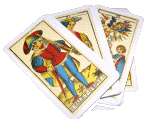
Bohemian Gothic Tarot
XIII DEATH
Lighter or more conventional meanings
A part of your self-identity "dies" or changes profoundly * A physical or spiritual death * The final closure of an important part of your life * A difficult transition that will shake you to the core.Darker, shadow or more hidden meanings
Acknowledging death, change and decay as an inescapable part of life * Feeling afraid of inner change, wanting to remain the same forever * Trying to deny or escape death.Death is the most notorious card in the tarot deck. It tends to show up in spectacular fashion in horror films, usually accompanied by portentous music. It's the card that many querents dread and that provokes endless debate among tarot readers. At one extreme, some readers will insist that Death stands for momentous change but never for actual, physical death, while others will tell you about the times that they have indeed seen it mean exactly this.
My own view is that the card does sometimes (though not often) mean death, not simply change. But we don't have to feel threatened by this. Death is, when you think about it, something familiar that's around us every single day. We see the death of plants and animals regularly. We read about death in the news and we encounter it occasionally among our own circle. It's good to be aware, in a reading, that even if the card does seem to stand for physical death it by no means points to the death of someone close to us, it could instead be interpreted simply as a "memento mori" ("remember we must die") sign, a reminder, in fact, that we must make the most of this life and live it to the full.
In a deck like The Bohemian Gothic Tarot death lurks in many of the cards - any work dealing with the Gothic by its nature has to deal with the dread of dying, the mysteries of the afterlife and our fear of the unknown aspects of both. It's in fact often claimed that the Gothic has such a powerful hold over the popular imagination precisely because it allows us to consider, in an entertaining and slightly distanced way, our attitudes to death and provides a certain catharsis that helps us to deal with our fears. If so, then this card may indeed have a carthartic element as it's exceptionally graphic; at once rather horrifying and yet also bizarre and surreal. It follows the tarot tradition in showing Death as a skeleton, looming over ordinary people, but it departs from it by showing the reality of the bodies; mummified and shrunken, they look forlorn and vulnerable. The depiction of Death himself is also unusual because he has eyes rather than empty eye sockets. It's a slightly comical rendering that owes something to many of the over-the-top skeletal figures seen in medieval "Memento Mori" paintings. However it's also a reminder, maybe, that Death sees everything and that there is no escaping him; a grim thought indeed.
But having said all this, do remember that when this card comes up in a reading, it is not to be seen as a horrible harbinger of imminent doom! The death that it speaks of is usually the demise only of a part of us - the death of an element of our identity that we hold dear. This in itself can be difficult but it's also a normal and necessary part of life. Maybe we have strongly identified with a job, a group that we are members of or the place where we live; the Death card could signal that these things now have to be left behind as we forge a new sense of self. This transformation might be difficult - parting with something that's been fundamental to your sense of who and how you are is often hard. But the Death card comes just before the judgement card's promise of a fresh start and a new life and this tells us that if we go through this transition new and wonderful possibilities may open up. This is a process to be embraced, not feared.
Some further ways to consider this card
Death carries an hour-glass in this picture. What does this mean to you? How would might reference to time influence your interpretation of this card? When the sand runs out in Death's hour-glass, what do you think happens?"O God!" half shrieked Ligeia, leaping to her feet and extending her arms aloft with a spasmodic movement, as I made an end of these lines - "O God! O Divine Father! - shall these things be undeviatingly so? - shall this Conqueror be not once conquered? Are we not part and parcel in Thee? Who - who knoweth the mysteries of the will with its vigour? Man doth not yield him to the angels, nor unto death utterly, save only through the weakness of his feeble will."
- Edgar Allan Poe, "Ligeia", Tales of Mystery and Imagination.









